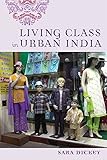Living Class in Urban India / Sara Dickey.
Material type: TextPublisher: New Brunswick, NJ : Rutgers University Press, [2016]Copyright date: ©2016Description: 1 online resource (282 p.) : 8 photographsContent type:
TextPublisher: New Brunswick, NJ : Rutgers University Press, [2016]Copyright date: ©2016Description: 1 online resource (282 p.) : 8 photographsContent type: - 9780813583914
- 9780813583945
- 306.30954/82 23
- HN690.M325 D53 2016
- online - DeGruyter
- Issued also in print.
| Item type | Current library | Call number | URL | Status | Notes | Barcode | |
|---|---|---|---|---|---|---|---|
 eBook
eBook
|
Biblioteca "Angelicum" Pont. Univ. S.Tommaso d'Aquino Nuvola online | online - DeGruyter (Browse shelf(Opens below)) | Online access | Not for loan (Accesso limitato) | Accesso per gli utenti autorizzati / Access for authorized users | (dgr)9780813583945 |
Browsing Biblioteca "Angelicum" Pont. Univ. S.Tommaso d'Aquino shelves, Shelving location: Nuvola online Close shelf browser (Hides shelf browser)

|

|

|

|

|

|

|
||
| online - DeGruyter Disney Culture / | online - DeGruyter When Riot Cops Are Not Enough : The Policing and Repression of Occupy Oakland / | online - DeGruyter From the Edge : Chicana/o Border Literature and the Politics of Print / | online - DeGruyter Living Class in Urban India / | online - DeGruyter The Psychic Hold of Slavery : Legacies in American Expressive Culture / | online - DeGruyter You've Always Been There for Me : Understanding the Lives of Grandchildren Raised by Grandparents / | online - DeGruyter College in Prison : Reading in an Age of Mass Incarceration / |
Frontmatter -- Contents -- Acknowledgments -- Notes On Transliteration And Pronunciation -- 1. Introduction: The Everyday Life Of Class -- 2. What Is Class In Madurai? -- 3. Four Residents, As I Know Them -- 4. Consumption And Apprehension: Class In The Everyday -- 5. Debt: The Material Consequences Of Moral Constructs -- 6. Performing The Middle -- 7. Marriage: Drama, Display, And The Reproduction Of Class -- 8. Food, Hunger, And The Binding Of Class Relations -- 9. Conclusions: Nuancing Class Boundaries -- Notes -- References -- Index -- About The Author
restricted access online access with authorization star
http://purl.org/coar/access_right/c_16ec
Many Americans still envision India as rigidly caste-bound, locked in traditions that inhibit social mobility. In reality, class mobility has long been an ideal, and today globalization is radically transforming how India's citizens perceive class. Living Class in Urban India examines a nation in flux, bombarded with media images of middle-class consumers, while navigating the currents of late capitalism and the surges of inequality they can produce. Anthropologist Sara Dickey puts a human face on the issue of class in India, introducing four people who live in the "second-tier" city of Madurai: an auto-rickshaw driver, a graphic designer, a teacher of high-status English, and a domestic worker. Drawing from over thirty years of fieldwork, she considers how class is determined by both subjective perceptions and objective conditions, documenting Madurai residents' palpable day-to-day experiences of class while also tracking their long-term impacts. By analyzing the intertwined symbolic and economic importance of phenomena like wedding ceremonies, religious practices, philanthropy, and loan arrangements, Dickey's study reveals the material consequences of local class identities. Simultaneously, this gracefully written book highlights the poignant drive for dignity in the face of moralizing class stereotypes. Through extensive interviews, Dickey scrutinizes the idioms and commonplaces used by residents to justify class inequality and, occasionally, to subvert it. Along the way, Living Class in Urban India reveals the myriad ways that class status is interpreted and performed, embedded in everything from cell phone usage to religious worship.
Issued also in print.
Mode of access: Internet via World Wide Web.
In English.
Description based on online resource; title from PDF title page (publisher's Web site, viewed 07. Jan 2021)


